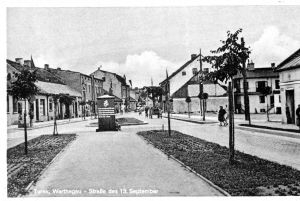Turek

Turek 1943
Turek is located 47 miles west - northwest of Lodz. The Jewish population of Turek stood at 2,678 in 1921, which comprised more than a quarter of the town's total population, which totalled approximately 8,000. At the time of the outbreak of the Second World War in September 1939, there were approximately 2,700 Jews living in Turek. Immediately after the German occupation the ill-treatment of the Jews commenced: the Germans seized Jews off the street for forced labour and started to confiscate Jewish property. The forced labour included repairing the damage inflicted by the German bombings. Sometimes the Jews were beaten and humiliated whilst carrying out this work.
In the first months of the German occupation, the synagogue was set on fire and partially destroyed and in October 1939, the German security forces shot fifteen Jews for reasons unknown. In November 1939, approximately 600 men from Turek were gathered in the synagogue and then forcibly deported to Bochnia, near Krakow. In January or February 1940, the first 'local' resettlement of Jews took place, when most of the town's Jews were concentrated in one of their pre-war traditional areas, along the 'Breite Gas' and 'Schmaler Gas.' Because of the deteriorating situation a number of Jews left Turek, seeking shelter in Warsaw, whilst some went to the Soviet-occupied part of Eastern Poland. By 1940, there were only approximately 1,750 Jews remaining in Turek.
The process of creating a ghetto in Turek took place over several months, beginning in the spring of 1940. Many buildings were rendered inhabitable because of the war damage, and due to housing shortages at least 150 Polish families lived in the designated ghetto area. As a result not all of the Jewish families could be moved into this area, and the Germans even considered removing the remaining Jews into the nearby countryside. As Turek was the seat of the Landratsamt and other regional authorities, all available living space in the town was taken up by newly arriving German members of the administration.
The establishment of the Jewish ghetto in Turek was completed in October 1940, complete with barbed-wire fencing; inhabitants of the ghetto were still able to enter it and leave it, enabling trade in property and food with the local Christian Poles to continue. German Schutzpolizei patrolled the ghetto perimeter, and they shot any Jews who tried to leave the ghetto without permission. Jews leaving the ghetto was not the only problem the German authorities faced, one of their main concerns was those Jews in the ghetto who were incapable of work. Constantly, able-bodied Jews were rounded up and taken to forced labour camps, which resulted in elderly, sick and the young remaining behind in the Turek ghetto. The German authorities became increasingly concerned that they would have to support these Jews using public funds, something they wanted to avoid at all costs.
Living conditions in the ghetto were horrible: terrible overcrowding and unsanitary conditions with only limited supply of food. The head of the Gestapo Aussendienstelle, for the Turek Kreis, and an unknown member of the German local labour office were in charge of the ghetto. According to the official records collected by the Polish Main Commission for the Investigation of Nazi Crimes, the ghetto held approximately 5,000 people from the town of Turek itself, and the neighbouring villages. Many Jews suffered from malnutrition, and therefore the Judenrat, chaired by Herszel Zymanowoda and his assistants Abram Bikowski and Haim Leib Eliasz, established a soup kitchen and other institutions of self-help. The Germans also initiated the creation of a Jewish Police force, under the command of Mordechai Strykowski.
The living conditions in the ghetto deteriorated further in the summer and autumn of 1941, following the German invasion of the Soviet Union. More and more men were rounded up during raids on the ghetto and sent to forced labour camps in the Poznan (Posen) area. By the end of September or in early October 1941, the Jews of the Turek ghetto were resettled into the rural ghetto of Kowale Panskie region, just south of Turek. Approximately, 4,000 Jews from towns and villages in the Turek region, such as Brudzew, Dobra, Turek, Tuliszkow, and Wladyslawow – were concentrated here in approximately 16 hamlets in the countryside. In Turek itself, there remained only a few skilled workers needed by the German authorities. Most probably, these Jews were eventually deported to Lodz in the summer of 1942, when the Turek ghetto ceased to exist.
The Jews in Kowale Panskie hamlets were murdered at the Chelmno death camp in gas vans in December 1941 and in the final 'Aktion' during May 1942. A few Jews from Turek who had been resettled to Lodz or to forced labour camps survived the war, a figure of only 26 in all probability is too low, but the destruction of the Jews of Turek, was virtually completed.
Sources:
The Encyclopaedia of Camps and Ghettos 1933-1945, USHMM, Indiana University Press Bloomington and Indianapolis 2012
© Holocaust Historical Society 2015

